Teaching players is an incredibly difficult task to do, and yet a task that will be among the most important to tackle during the development of our games:
- It is paramount in the future experience of our players: a badly introduced feature may result in entire sides of the gameplay that players will omit, reducing their agency, or simply blocking them at a key moment in the game. Worse, a feature wrongly introduced may teach something false, creating beliefs, and understanding that simply aren’t in the game.
- It is one of the main reasons behind brutal day-1 drop rates: our players are highly volatile. A convoluted teaching phase, a lengthy one, or simply a non-engaging one will make our players drop the game for another, more intuitive.
- It is highly dependent on the players themselves: players want to jump in the action right away. Their willingness to work for it is close to none. Also, efficient teaching takes into account the background of each student: their socio-cultural origins, their previous experience with the medium/genre/IP/game. As our games target a wide array of players, designing efficient learning phases becomes a complex challenge…
Unfortunately, learning phases are often minimized and tackled way too late during production, leading to missed opportunities and emergency solutions that can have long-lasting effects, rippling through the entire game.
One situation that sticks with me is a particular teaching failure in Assassin’s Creed: Origins. And it is related to the Dodge mechanic.
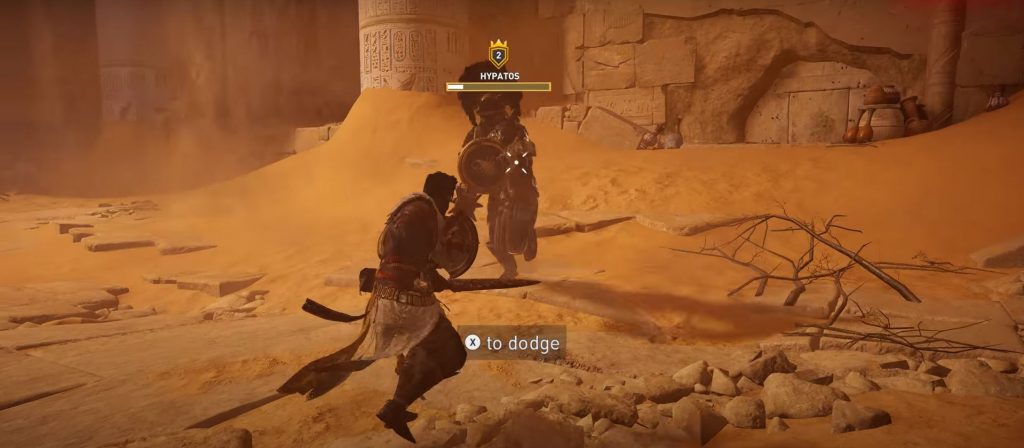
The fighting system of AC:O can be simplified in its most barebone form as a rock-paper-scissor system composed of three elements: offense (the players set of attacks), defense (block and parry mechanic), and avoidance (dodge). These three elements answer each other in plenty of ways: unparriable attacks, dodge repositioning for a stronger offense, guard breaks… and each of them is a crucial part of the combat that each player must master.
Enemies in the game are, of course, designed to play enormously with this system: Windows of Opportunities, wind-up, move-sets, behavior, strength, and weaknesses… Each of them exists for a specific purpose and to push players to use different strategies and mechanics without ever locking them into a mandatory one (supporting mastery without suppressing player’s agency).
Which brings us to bosses in the game, particularly the final bosses of the last DLC: The Curse of the Pharaohs. As the final challenges of the entire AC:O experience, they must push these mechanics to the extreme. Two of these bosses, particularly, put a strong accent on the dodge mechanic. That would be a shame if, at this moment, many players failed to learn the dodge mechanic properly right? Well, unfortunately, this is exactly what happened, and the fault is on the teaching phase of this specific feature.
The dodge mechanic is taught at the start of the game, with a simple contextual prompt, in the middle of the first fight. Even though it is repeated multiple times (after playtests showed that this mechanic needed to be reinforced), the game will never remind the player, nor put him in a situation where dodging is mandatory. It is also taught at the same time as multiple other key-mechanics. Players do not build the reflexes to use this mechanic and end up forgetting about it entirely. The results are plenty of frustrated players finding some bosses way too hard, or the combat system not deep enough.
There are plenty of different approaches when dealing with teaching methodologies, and we will dig into them precisely in an upcoming article. But there is one teaching approach that deserves its own article: organic teaching.
This approach is widely regarded as the ultimate one, the Graal of teaching. Much like Diegetic UI has been (and still is) considered as the most elegant and frictionless approach to UI, the one that puts as little layers between players and their experience, organic teaching (sometimes even called “Invisible Tutorial”) is praised by many as it makes tutorials disappear in the actual experience.
Unfortunately, as a “one rule fits all” is never true when talking about design, things are a little more complex than they appear… And much like Diegetic UI comes with its rules and limitations, Organic Teaching will come with its own implementation complexities.
In this article, we will thus try and break down the theory behind this teaching approach, and look closely at the game of a member of the GDKeys community that implemented it impressively well: Exophobia.
Exophobia
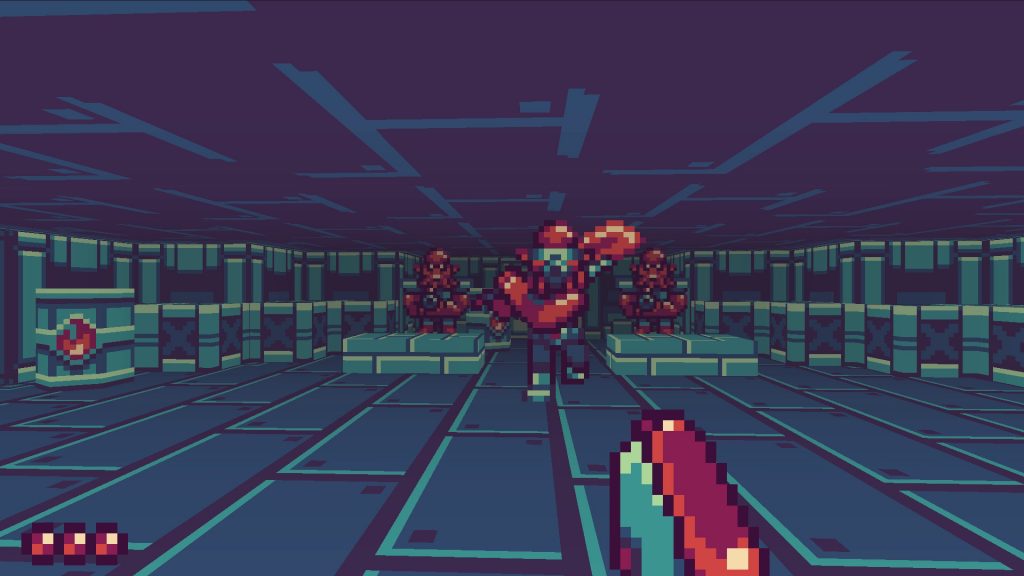
Exophobia is an amazing retro game that will bring you back in time in the heat and pixels of the original doom-like games. It is taking everything that was good from it, and polish the gameplay and execution to make it 2020 ready. It’s a gold nugget of a game, and you should definitely check it out!

It defines itself as follow:
“Exophobia is a retro-inspired first person shooter with fast-paced combat. You wake up to find yourself alone in a human spaceship infested with hostile alien soldiers. Explore your surroundings while you uncover piece by piece the backstory and destiny of its human inhabitants. Shoot, dash, stun your enemies and more, in your path to escape!”
Go check their >> STEAM PAGE <<, or their >> OFFICIAL WEBSITE <<
You can also check the demo of the game on the walkthrough below:
Not only the gameplay is nervous, the OST perfect and the nostalgia real, the game also packs, as I was telling you, an amazing feat of organic onboarding! But we will need a bit of theory before jumping in, to know what we are talking about…
In order to properly approach our topic, we will need to have some sort of pre-requisite at hand. A base to analyze what works, and what doesn’t. First of all, we will need to reword our title a little bit: instead of calling it “organically teaching players” we should actually start calling it by what it really is! What we are going to do here, is build, encourage, reinforce, and discard players’ mental models. And this is a pretty fascinating topic.
Mental Models
In 1943, Kenneth Craik theorized mental models as follow:
A mental model is a kind of internal symbol or representation of external reality, hypothesized to play a major role in cognition, reasoning and decision-making.
We could explain it as follow: in order to deal with the insane amount of information our brain is subjected to constantly, we build models, an enormous amount of them. Those are sets of rules, attributes, and behaviors that we construct in order to explain, interact, and predict the world around us. It is our own alternate reality that in most cases allows us to stay alive and functioning! We know that glass is fragile and potentially dangerous, we will then be very careful around solid transparent surfaces. this example is extremely straight-forward but it is one among millions that we built throughout our lives.
We actually get them from 3 different sources: built-in knowledge (like babies knowing that smiles are a positive thing), extrapolation from past experiences (everything you have learned in your life, like our glass example), and experimentation of course (try something, make connections, draw conclusions, store it).
And they are deeply flawed! These mental models are based on unquantifiable, obscure, or incomplete facts. They are the simplified personal reality we built for ourselves to explain the world.
Now, how does this affect us, video game designers, and why is it so important? Simply because each of our games is its own reality. A reality that players do not know about (and are willing to learn about). Are glass bottles dangerous in your game? Are windows breaking? Do you get sick by eating too many candies? Do you die by taking a single gunshot to the chest? How long can you hold clinging on a ledge before falling to your death?
Nothing is working as it should, and everything must be learned again by our players! Or actually, almost everything: the “extrapolation from previous experience” source is actually encompassing previous gaming experience! Convenient right? Well not so much. What if your game isn’t working like previous games were? Then you are quite in a pickle, aren’t you?
Fortunately for us, players (and humans in general) are constantly experimenting, trying, supposing, testing… They build new models constantly. and adapt fairly fast. That of course, if they build proper models. Which is exactly our challenge today.
Let’s take an example that is particularly efficient (and not at all because designers love to talk about it constantly)
The door problem
Have you ever realized how many mental models you built just to tackle doors in real-life?

So many different kinds, so many interactions to memorize: strength to apply, movement combination, anticipation, dangers, etc. Just to open and close doors! So many ways that our game won’t ever be able to reproduce!
That’s a pretty brutal issue indeed. In this case, we will need to re-teach everything to our players. Fortunately, decades of games had to tackle this problem and you should now have, in parallel, a pretty strong set of mental models to deal with virtual doors!
Let’s try and list the most frequent:
- Push to interact doors: a single key/button press. A classic.
- Doors opening automatically on approach (cf. Control). Convenient.
- Virtual button to push/panel to interact with. A slightly more complex versions on the push to interact ones, composed of two ingredients.
- Fake doors. The eternal curse of every environment artist.
- Timer doors. Activated remotely.
- The locked doors: using keys, keycards, or activating a special set of conditions (ala Portal).

And your players, should they not be complete newcomers, will know these too! They will instantly recognize the shape of a door (built-in knowledge), browse their set of models (extrapolation from past experiences), and try to interact with them (experimentation) until they figure out how the doors in your game work. They will finally hard-wire this new model into their brain.
But now let’s imagine you want to make a new kind of doors in your game. one that won’t be understood that easily? Well, one game did that beautifully: Metro: 2033. And I will let you watch the first 20 seconds of the clip below, taken from the first 3 minutes of the game:
This bit of design is actually one that I cherish as one of the most efficient organic learning that I have encountered (and also… doors!). The devs not only knew about the mental models of their players, but they played with it in order to teach their own way. Let’s break it down:
- You, as a player, are tasked to “open the door”.
- Your first instinct will be to go for the handle with the flashy green light like you did so many times in other games.
- The game acknowledges your action, actions the handle and starts the opening of the door (as you expected).
- But then the door stops and the NPC explains to you why this won’t be valid here.
- Finally, the game invites you to interact with the wheel, perfectly placed between the handle and the door, in the player’s field of view, which opens the doors.
The devs didn’t only try and create a new mental model in their players: they took one apart in order to replace it with the new valid one that will be used over and over again during the game. It feels completely organic and is built within the storyline and the game’s fantasy. Perfection.
Organic Teaching
This introduction to the mental model theory was very simplistic but will give us everything we need to know to look at our topic with the right eye.
Organic teaching has been studied for quite some time as it is present in games from the dawn of the industry. It didn’t start because of a desire to be more immersive, but because of a need to teach players, in-game, in a world where the only way to incorporate proper tutorials was through the booklet accompanying the cartridges (or from mouth to ear).
Super Mario Bros. 1-1 world is probably the most emblematic case study of them all, teaching everything the player needs to know by carefully placing the game’s ingredients in a progressive and combined manner:
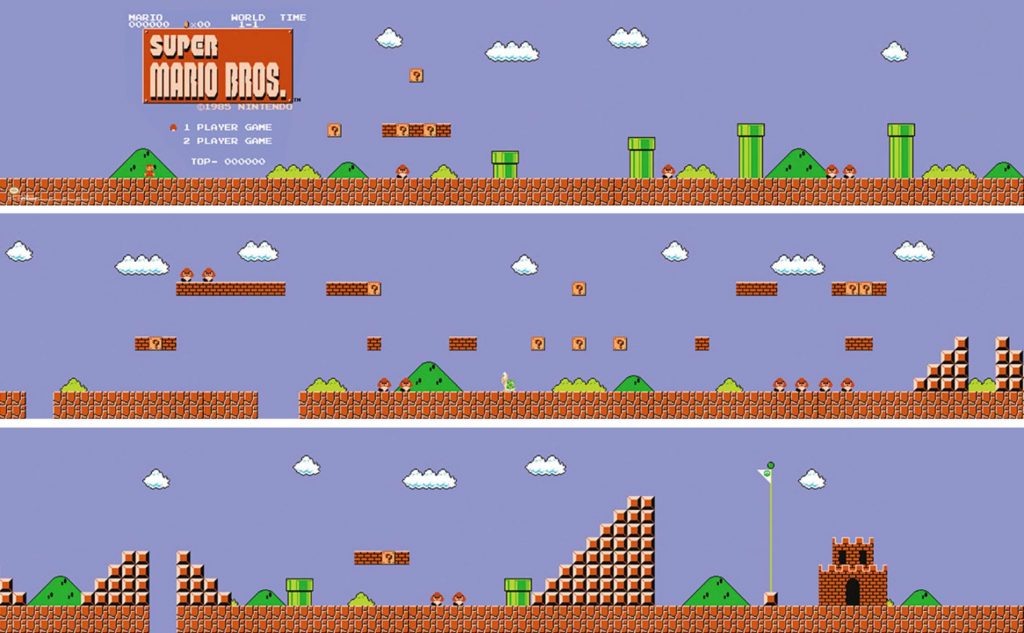
But plenty of other games managed beautifully too, through clever level design, setup, or even Signs & Feedback. I will now invite you to watch two very insightful videos. The first one is “Half-Life 2‘s Invisible Tutorial” by GMTK.
Warning: now that you are basically professionals in cognitive psychology and mental models (big time!), look at these videos with our previous theory in mind. Be particularly careful of the 3 sources of mental models we discussed previously:
- Build-in knowledge: the nature part of human beings, like shapes, survival, facial expressions, perspective, 3D projection…
- Extrapolation from past experiences: the nurture part, our backgrounds, both with games and with real-life, much tied to our socio-cultural background.
- Experimentation: the creation of new models based on our shenanigans inside games and in real-life. Ever seen babies trying to eat sand?
The second video is about the intro stage of MegamanX by Sequelitis. Watch directly from 5:48 to 14:30 if you are only interested in our topic at hand, but the entire video is very much worth it!
Now, before we head into the ins and outs of Exophobia‘s teaching approach, I’d like to go a bit deeper into one specific source of mental model: the players’ Experimentation part.
Player’s Experimentation
When we talk about player’s experimentation in a game, we directly picture a very personal, free form process, like a baby in a sandbox. But the reality is extremely different: what we are really doing, is guided experimentation.
We know exactly what we want to teach the player, but we also understand the amazing power of learning by doing and we guide the players to draw the right conclusions by themselves.
And you know what genre of games behave the exact same way? Puzzle games. In essence, players’ experimentation is no different than having them solve puzzles. And the same design approach can be taken: introduction, reinforcement, refreshing, challenge…
Portal 2 onboarding phases are actually a goldmine in this light, as it is taking the puzzle approach in the experimentation, well… pretty literally.
The picture below represents the first encounter between the player, an exit door, and a pressure button to open it.
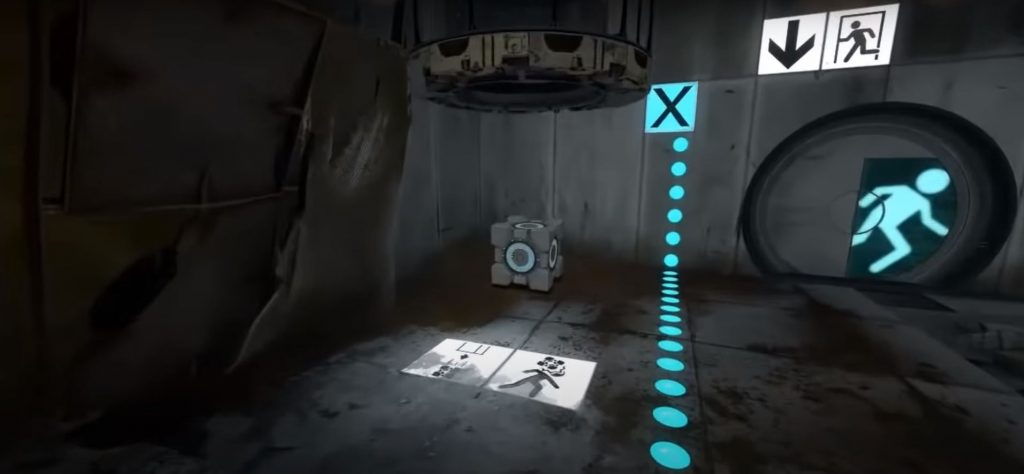
Asher Einhorn, game designer at Naughty Dog and Disney Infinity, resume the process of solving a good puzzle in 4 sequential steps:
- 1- Understand the objective, notice a problem: realize a door is locked, an exit is out of reach, a box isn’t opening, etc.
- 2- Discover the puzzle: realize that there are elements that could help solve the aforementioned issue, experiment with them, and discover their usages.
- 3- Project on the solution: connect the pieces together and figure out how to solve the puzzle. The “Aha!” moment. This is the successful thought process, the final connection.
- 4- Implement the solution, solve the problem: the satisfaction and rush of endorphins! The actions following your careful thought process.
Now, let’s look back at our portal tutorial and see if these steps apply:
- Understand the objective, notice a problem: the only exit, the door, is closed and not opening. “I need to find a way to open it!”.
- Discover the puzzle: The door is connected to a big red button, at the end of a connection line that shows an “X” on it. Stepping on it visually highlight the connection, turn the “X” in an approval tick, and open the door! But stepping off of it closes it back. There is also a cube there that I can move around.
- Project on the solution: “If I put the box on the button, it activates it and allows me to pass!”
- Implement the solution, solve the problem: success!
So let’s sum it up:
Organically teaching players through experimentation is about building puzzles and leading them to the solutions,
Straightforward enough, but with a very important warning to put here. Your end goal as a designer isn’t to make a smart, one of a kind, compelling puzzle. Your goal is to have all your players build the proper mental model while solving it. And this will force us to be very wary: some things that are considered common in puzzle design (and even best-practices) are going to lead to catastrophes here. Let’s look at some:
- “A good puzzle prevent the player to reverse engineer the solution”: very true! But in our case counter-intuitive. Our puzzles aren’t about the challenge of it, but about letting the player come up with the connections between the game’s ingredients and suppose the interactions between them. Reverse-engineering the solution is actually a very good thing here!
- “A good puzzle opens multiple solutions, and contain dead-ends“: now this could be a good thing no? Experimenting with what works, and what doesn’t? Yes, but with a subtlety: every dead-end should lead the player to build a bigger understanding of the game. Like our example of Portal 2: stepping yourself on the button seems viable until you realize that it won’t allow you to pass the door, learning on the way that this button isn’t a switch, but a push-button.
- “A good puzzle throws the player off-guard, and hides the solution“: now this is dangerous. Do you know what is worse than failing to teach our players? Teaching them the wrong things. If a player gets confused during the creation of a mental model, he could very much create a faulty one, one that doesn’t apply to our game. This will have terrible consequences on their playthrough, and breaking this faulty model will be a painful process, both for us and the player.
To summarize:
Build simple puzzles, with a single solution, a non-interpretable result and clear steps to get to it.
Remember that players are humans and that humans are wired to try and build models over everything they interpret, being true or false. Do not teach exceptions. Do not leave room for misinterpretation.
Organic teaching in Exophobia
We finally have enough background to look at some of the most beautifully implemented tutorials of Exophobia. And actually, we are going to talk about a topic we haven’t discussed in a long time! Doors of course!
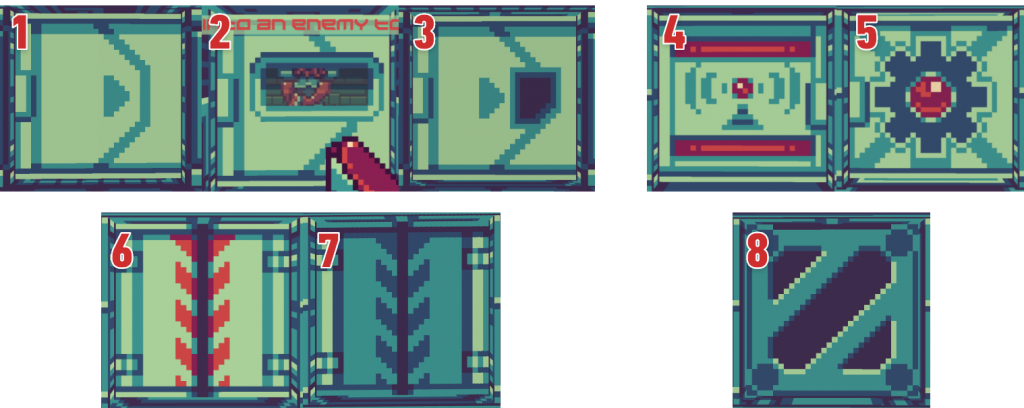
Here are all the doors that are contained in the demo of Exophobia. And they are actually pretty well designed!
First, you have the classic doors. You press the action button when close to it, and the door slides open. It can exist with or without a see-through window (door #1 and door#2). This taps into the mental models of past experiences of most gamers and a text tutorial highlights it for you in front of the first door to secure the learning. Simple and efficient.

Door#3 is your typical locked door. Find the key (in our case, a keycard), open the door with it. This obviously taps into previous game experiences and a simple player extrapolation will do the work here. But the game goes one step beyond and provides a physical socket in the door, asking the player to embed in it its homothetic access card. This is another mental model at play here: a built-in one, as humans are extremely good at recognizing shapes and drawing conclusions from their attributes.

Door#4 and door#5 are the two doors leading to critical player-rooms: the saving area, and the upgrade one. Both of them have dedicated iconography (past real-life experience): a network/info point, and a gear. They also contain the color red, associated positively in most cultures. Smart.
Then we have door#6 and door#7. These are a bit more tricky. They represent the 2 sides of a door that can only open when either pushing its dedicated button or actioning its lever. These two being located sometimes far away from the door itself (challenging on the puzzle side of things).
I’d argue that several things could be improved here. The stripes iconography doesn’t tap into known mental models, and the color red could be misleading for something positive (as seen on the previous two doors). I’d argue that it would have been better in yellow (utilitarian + grab the attention). But since this article is about teaching and not Signs & Feedback, we will assume that these doors’ assets can’t be changed. In this case, our only way to deal with this issue will be to have the players build a new mental model through experimentation. And this is exactly what Exophobia is doing. The first encounter with these doors is a dead-simple puzzle, where the answer is even given to the player textually. Notice how all the elements are visible on the screen? Yeah, that’s a good best-practice too.
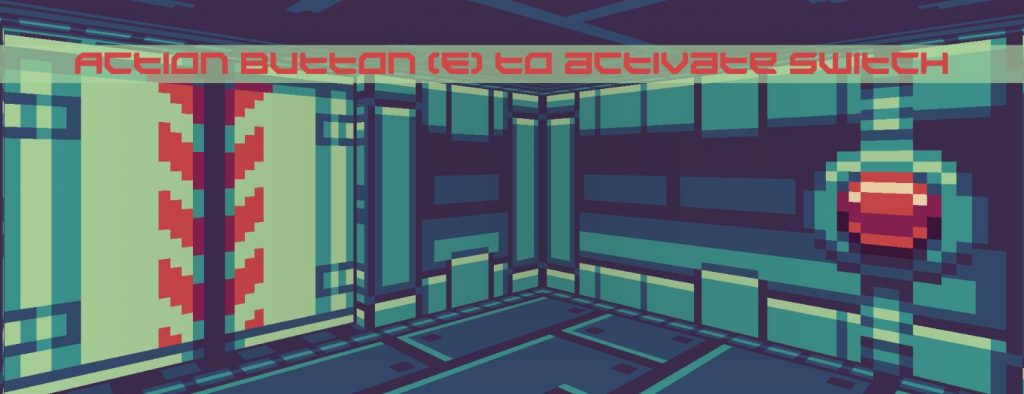
The game will then multiply the situations, to anchor this new behavior in the player as well as its subtleties.

And finally, we have door#8, let’s call it “The Hatch”. And this one is the real deal! Very complicated to explain, hidden at the start, mandatory later… It needs to be taught in steps, and carefully. And Exophobia pulled a case-study of beautiful design on this one.
The Hatch
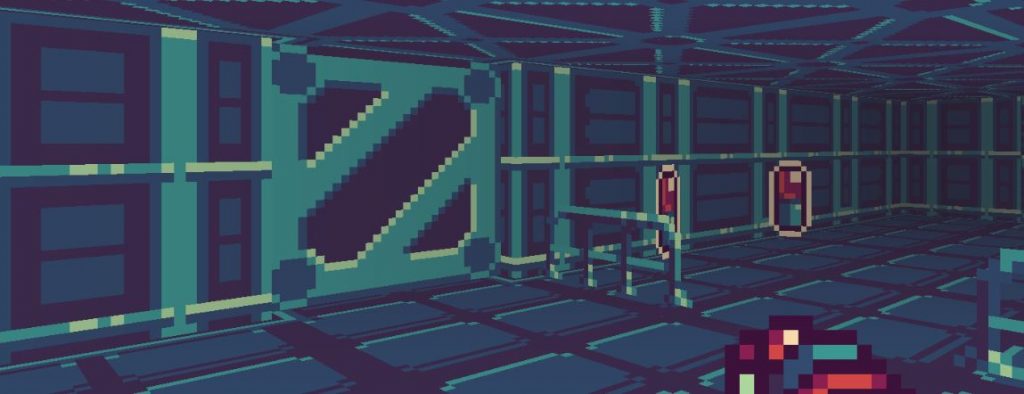
Let’s start with the challenges of this specific door. It’s an advanced door, that can only be “opened” by blasting it open. Its primary purpose is to open the level design in the later stage of the demo. So let’s break down the 3 phases of learning that must happen:
- “It doesn’t exist”. at the start of the game, the player shouldn’t bother with it. It shouldn’t exist in his experience more than its asset being noticed in an unconscious way. This is only noise.
- “Oh! These things actually CAN be opened!”. Shortly before giving to the player the tools to open these doors, the game is teasing the functionality surrounding this ingredient.
- “Eh, you know what? Now I think I can open them myself!”. The puzzle resolution part, having players connecting the dots and figuring out what they can do. In our example, use their newly-acquired gun upgrade to blast them open.
Phase 1 is approached by having the hatch look very dull in the environment. For most players, it is just a decorative wall asset that will be ignored. Perfect. Now, what if a player digs more and tries to shoot at this thing? The panel will vibrate, suggesting an interaction but nothing strong enough to suggest a way around it.
We know have players that completely omit this thing, which is great! But fast-forward to the middle of the demo: how do we break this mental model, and rebuild a new one over it showing that, contrary to your assumptions, these things CAN be broken? Using another mental model of course!
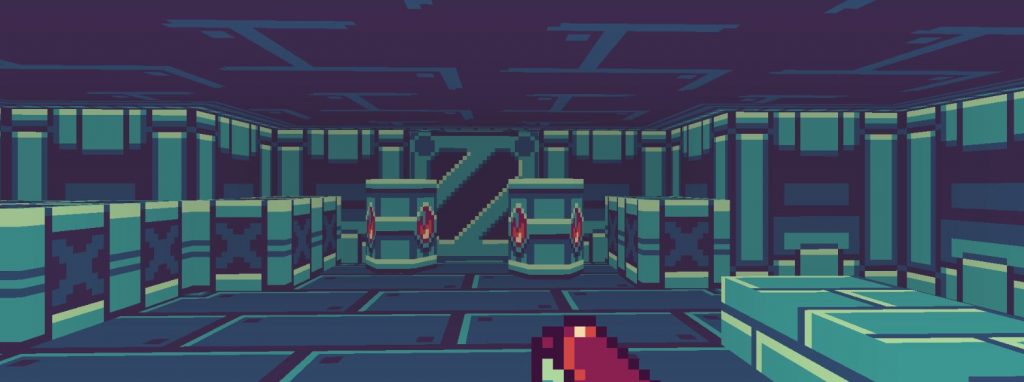
Red explosive barrels. One of the most iconic metaphors of our medium. I don’t have analytics, but I’m pretty sure that nearly 100% of players will shoot at them when seeing one. And it happens that the ones in this picture are pretty conveniently placed! And if you shoot one of them…
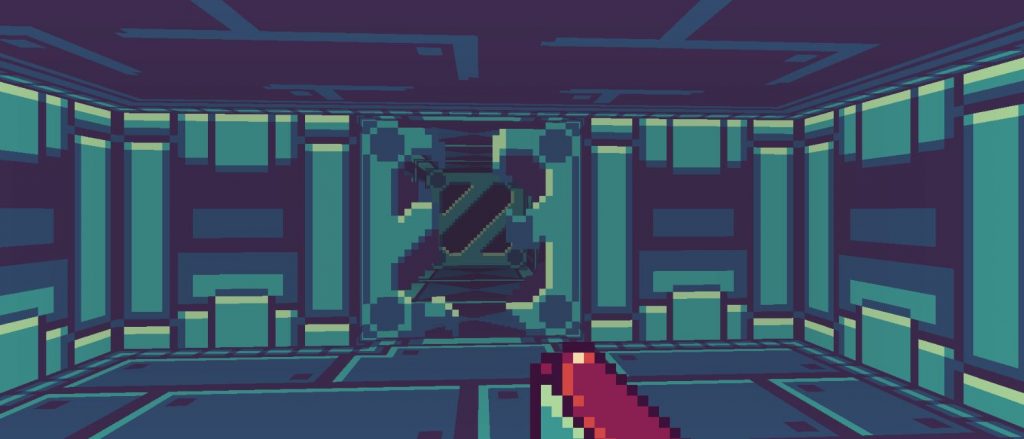
Bam! Door opened! Not only that but another one stands right behind it. One that does not have any explosive barrels around it (if the player didn’t shot one before, he will try now). Phase 2 complete. Now to phase 3.

The player is now being given an upgrade to his gun. One that allows him to charge it to shoot powerful blasts. And these blasts very much break open all the hatch in the game! Now we need to explain that to the player!
So let’s imagine the player flow: “I enter the room, glitters everywhere, my gun is put in the machine and starts being powered-up, I get it back, it’s awesome! I want to try this blast on everything! So I turn around to exit the room and what is the first thing I see?”

GE.NIUS.
It feels so natural for the player, and yet it is so properly guided! I have no doubt this hatch will be instantly blasted, whatever type of player is behind the controller.
Now, you may think that I was talking essentially about doors because of my twisted designer kinks. This may be partially true, but there is also a bigger reason: Exophobia is a room-based game. Doors represent progression, paths, achievement. A new door is an item of great interest for a player. And Exophobia used this knowledge to introduce a huge amount of content!
How do you teach players that shooting at boxes break them?
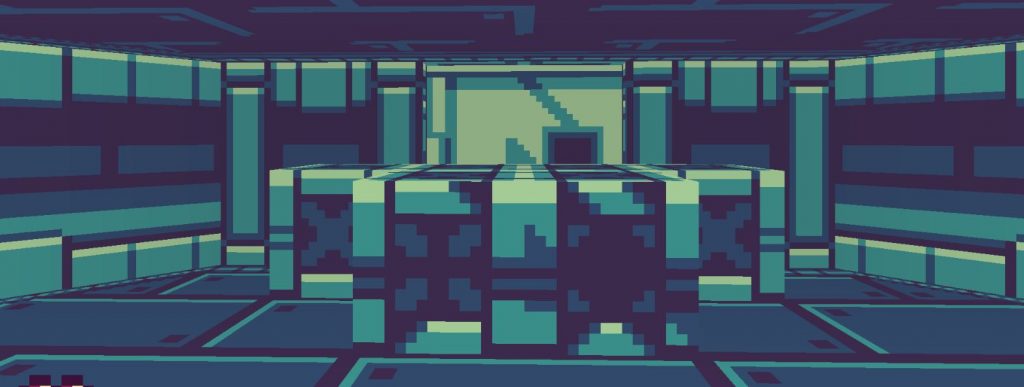
Put some in front of a door of course! Not only that, but this door is a locked one, meaning that a keycard will need to be found. And for sure, now that players know they can shoot boxes, they will break them all! That’s convenient because…
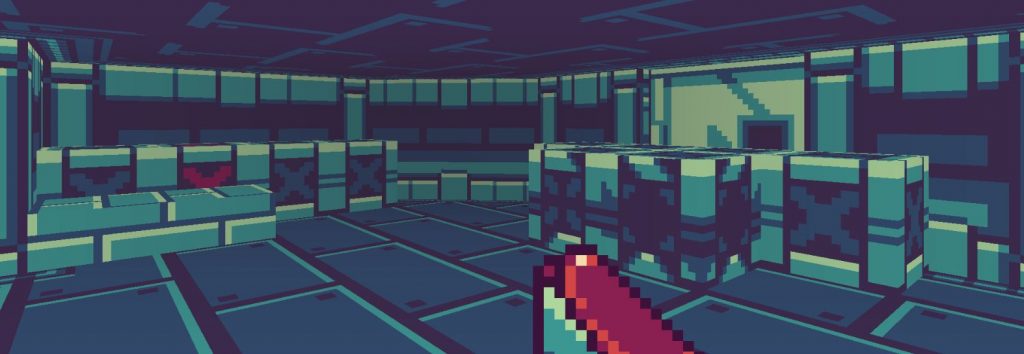
There are more boxes next to it! Especially a red one, which, surprise, contains the key card. Now players know that red boxes contain valuable items.
But it takes several shots to break a box. The upgraded blast, on the other hand, could blow through multiple of them in one shot. That would be great to have a situation explain…
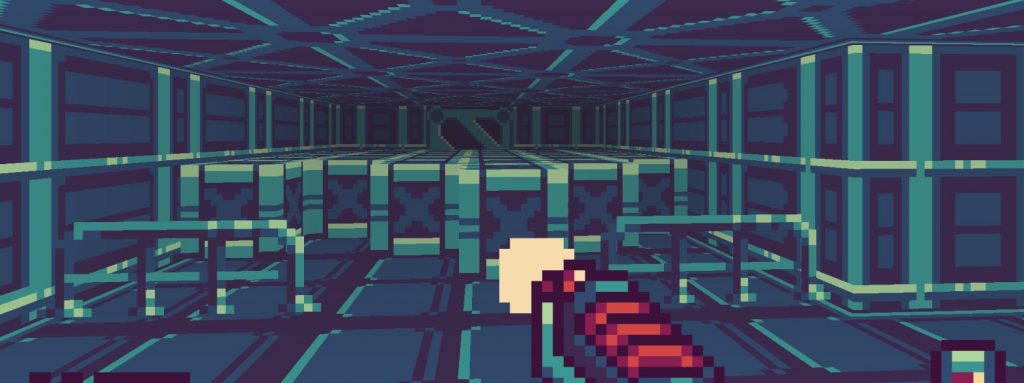

Nevermind, we have one.
And there would be so much more to say about this demo! But I will let you discover them by yourself. The Steam page of the game has a free demo to try, and I can’t recommend it enough!
This topic of teaching is far from over on GDKeys, and we will have much to talk about, but mental models are an extremely interesting approach that was worth introducing here. It’s a complex topic, highly debated, and a single article won’t ever be able to cover as much as this topic deserves, but I hope that you will now have the first bricks of understanding to analyze games, spot mistakes, and refine your games when faced with players missing something important in them, or simply wanting to break from the classic textbox tutorials.
Do you want to get regular quality articles on Game Design and join an awesome community of devs and designers on our private Discord to discuss design, learn, and review each other’s games? Then consider supporting GDKeys.

Share your Experience